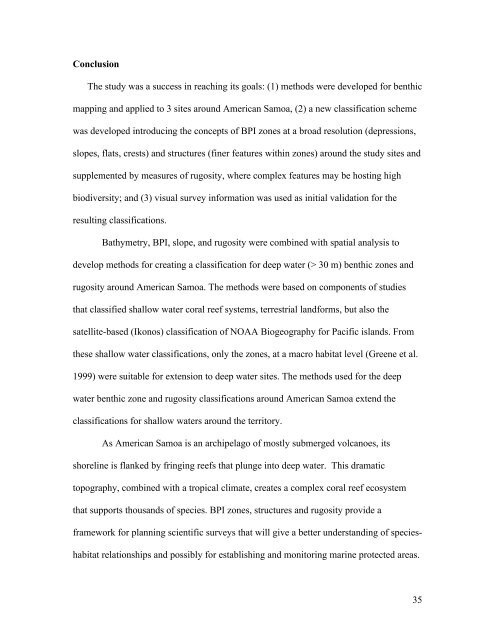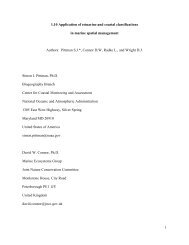A Benthic Terrain Classification Scheme for American Samoa
A Benthic Terrain Classification Scheme for American Samoa
A Benthic Terrain Classification Scheme for American Samoa
You also want an ePaper? Increase the reach of your titles
YUMPU automatically turns print PDFs into web optimized ePapers that Google loves.
Conclusion<br />
The study was a success in reaching its goals: (1) methods were developed <strong>for</strong> benthic<br />
mapping and applied to 3 sites around <strong>American</strong> <strong>Samoa</strong>, (2) a new classification scheme<br />
was developed introducing the concepts of BPI zones at a broad resolution (depressions,<br />
slopes, flats, crests) and structures (finer features within zones) around the study sites and<br />
supplemented by measures of rugosity, where complex features may be hosting high<br />
biodiversity; and (3) visual survey in<strong>for</strong>mation was used as initial validation <strong>for</strong> the<br />
resulting classifications.<br />
Bathymetry, BPI, slope, and rugosity were combined with spatial analysis to<br />
develop methods <strong>for</strong> creating a classification <strong>for</strong> deep water (> 30 m) benthic zones and<br />
rugosity around <strong>American</strong> <strong>Samoa</strong>. The methods were based on components of studies<br />
that classified shallow water coral reef systems, terrestrial land<strong>for</strong>ms, but also the<br />
satellite-based (Ikonos) classification of NOAA Biogeography <strong>for</strong> Pacific islands. From<br />
these shallow water classifications, only the zones, at a macro habitat level (Greene et al.<br />
1999) were suitable <strong>for</strong> extension to deep water sites. The methods used <strong>for</strong> the deep<br />
water benthic zone and rugosity classifications around <strong>American</strong> <strong>Samoa</strong> extend the<br />
classifications <strong>for</strong> shallow waters around the territory.<br />
As <strong>American</strong> <strong>Samoa</strong> is an archipelago of mostly submerged volcanoes, its<br />
shoreline is flanked by fringing reefs that plunge into deep water. This dramatic<br />
topography, combined with a tropical climate, creates a complex coral reef ecosystem<br />
that supports thousands of species. BPI zones, structures and rugosity provide a<br />
framework <strong>for</strong> planning scientific surveys that will give a better understanding of specieshabitat<br />
relationships and possibly <strong>for</strong> establishing and monitoring marine protected areas.<br />
35
















